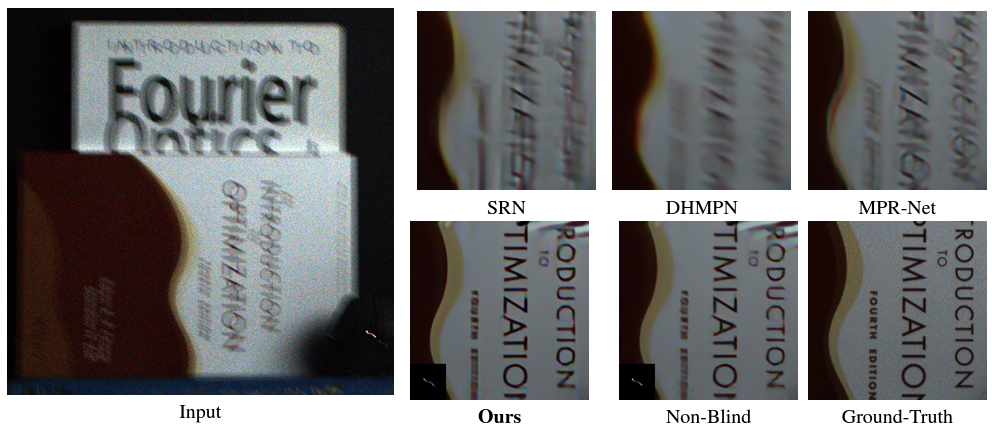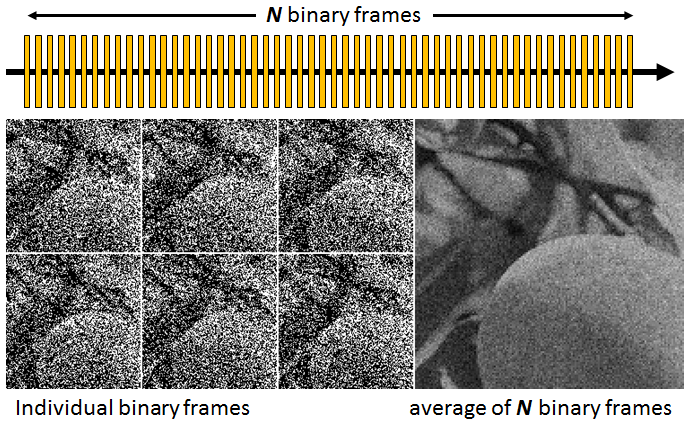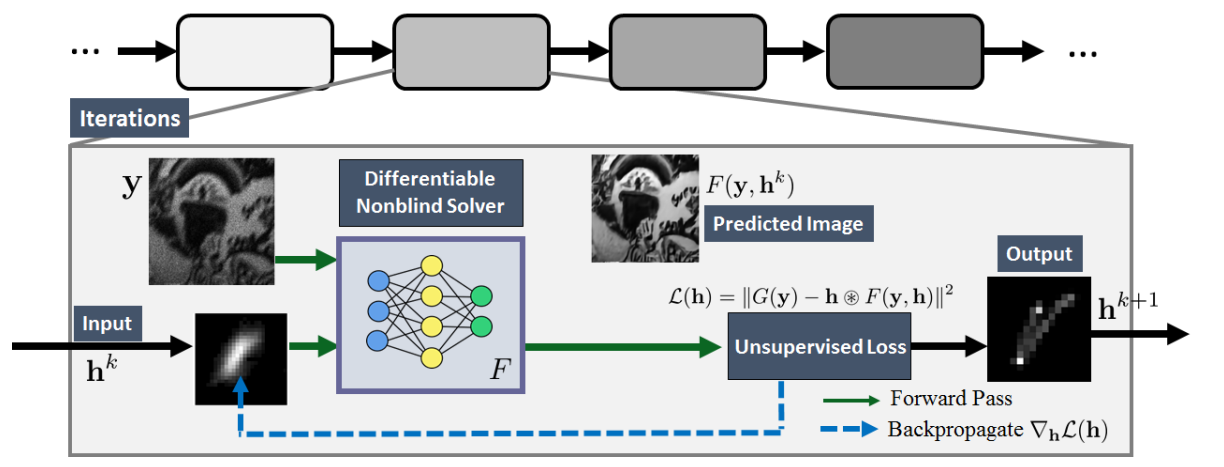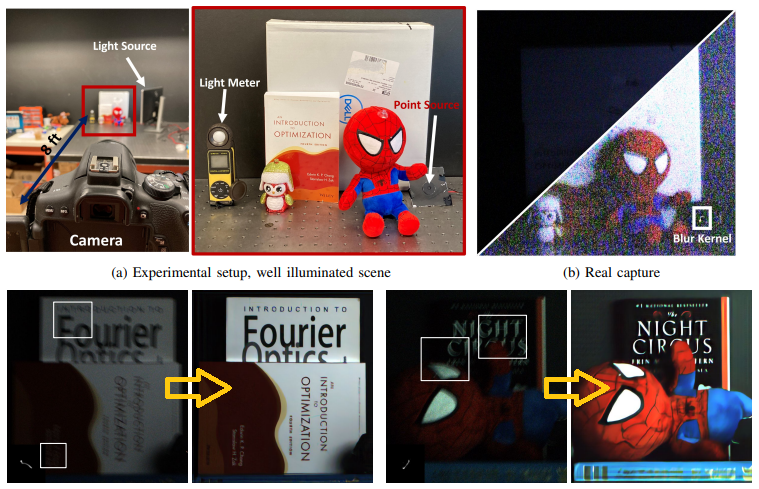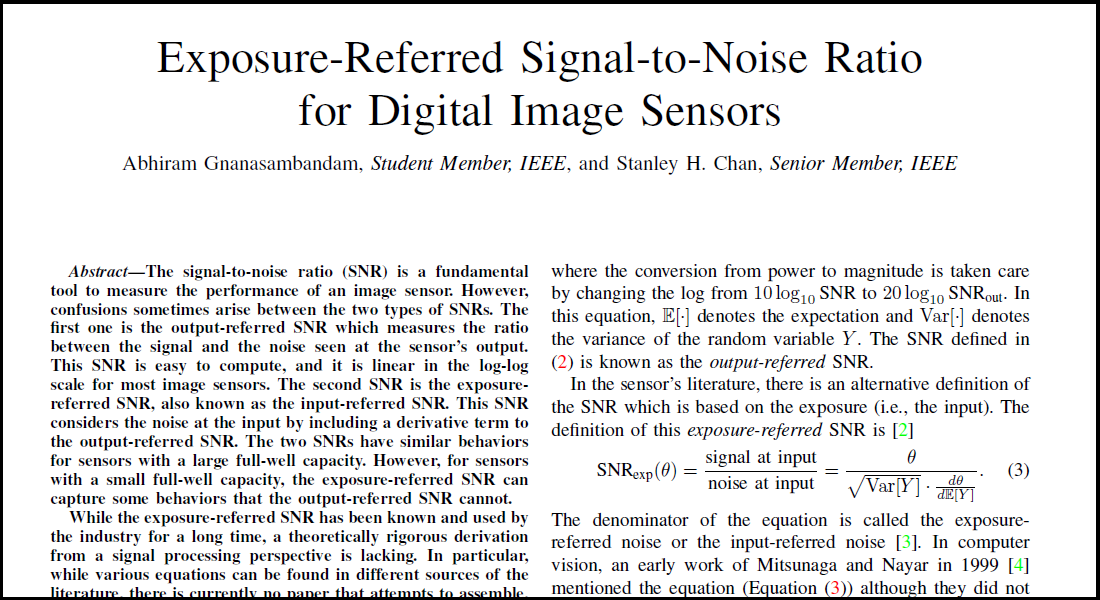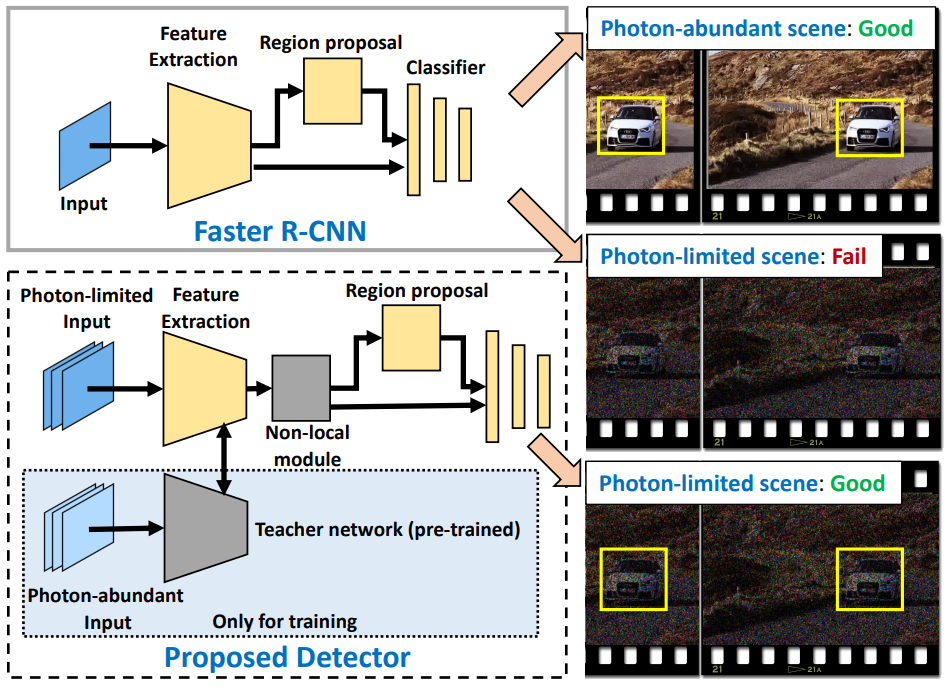Photon-Limited Imaging
Generative Quanta Color Imaging
IEEE/CVF Conference on Computer Vision and Pattern Recognition 2024
Vishal Purohit, Junjie Luo, Yiheng Chi, Qi Guo, Stanley H Chan, Qiang Qiu
Manuscript: https://arxiv.org/abs/2403.19066
The astonishing development of single-photon cameras has created an unprecedented opportunity for scientific and industrial imaging. However the high data throughput generated by these 1-bit sensors creates a significant bottleneck for low-power applications. In this paper we explore the possibility of generating a color image from a single binary frame of a single-photon camera. We evidently find this problem being particularly difficult to standard colorization approaches due to the substantial degree of exposure variation. The core innovation of our paper is an exposure synthesis model framed under a neural ordinary differential equation (Neural ODE) that allows us to generate a continuum of exposures from a single observation. This innovation ensures consistent exposure in binary images that colorizers take on resulting in notably enhanced colorization. We demonstrate applications of the method in single-image and burst colorization and show superior generative performance over baselines.
Project Page: https://vishal-s-p.github.io/projects/2023/generative_quanta_color.html
Spatially varying exposure with 2-by-2 multiplexing: Optimality and universality
IEEE Transactions on Computational Imaging
Xiangyu Qu, Yiheng Chi, Stanley H Chan
Manuscript: https://arxiv.org/abs/2306.17367
The advancement of new digital image sensors has enabled the design of exposure multiplexing schemes where a single image capture can have multiple exposures and conversion gains in an interlaced format, similar to that of a Bayer color filter array. In this article, we ask the question of how to design such multiplexing schemes for adaptive high-dynamic range (HDR) imaging where the multiplexing scheme can be updated according to the scenes. We present two new findings. 1) We address the problem of design optimality . We show that given a multiplex pattern, the conventional optimality criteria based on the input/output-referred signal-to-noise ratio (SNR) of the independently measured pixels can lead to flawed decisions because it cannot encapsulate the location of the saturated pixels. We overcome the issue by proposing a new concept known as the spatially varying exposure risk (SVE-Risk) which is a pseudo-idealistic quantification of the amount of recoverable pixels. We present an efficient enumeration algorithm to select the optimal multiplex patterns. 2) We report a design universality observation that the design of the multiplex pattern can be decoupled from the image reconstruction algorithm. This is a significant departure from the recent literature that the multiplex pattern should be jointly optimized with the reconstruction algorithm. Our finding suggests that in the context of exposure multiplexing, an end-to-end training may not be necessary.
PCH-EM: A solution to information loss in the photon transfer method
IEEE Transactions on Electronic Devices, 2024
Aaron J. Hendrickson, David P. Haefner, Stanley H. Chan, Nicholas R. Shade, Eric R. Fossum
Manuscript: https://arxiv.org/abs/2403.04498
Working from a Poisson-Gaussian noise model, a multi-sample extension of the Photon Counting Histogram Expectation Maximization (PCH-EM) algorithm is derived as a general-purpose alternative to the Photon Transfer (PT) method. This algorithm is derived from the same model, requires the same experimental data, and estimates the same sensor performance parameters as the time-tested PT method, all while obtaining lower uncertainty estimates. It is shown that as read noise becomes large, multiple data samples are necessary to capture enough information about the parameters of a device under test, justifying the need for a multi-sample extension. An estimation procedure is devised consisting of initial PT characterization followed by repeated iteration of PCH-EM to demonstrate the improvement in estimate uncertainty achievable with PCH-EM; particularly in the regime of Deep Sub-Electron Read Noise (DSERN). A statistical argument based on the information theoretic concept of sufficiency is formulated to explain how PT data reduction procedures discard information contained in raw sensor data, thus explaining why the proposed algorithm is able to obtain lower uncertainty estimates of key sensor performance parameters such as read noise and conversion gain. Experimental data captured from a CMOS quanta image sensor with DSERN is then used to demonstrate the algorithm's usage and validate the underlying theory and statistical model.
The Secrets of Non-Blind Poisson Deconvolution
IEEE Transactions on Computational Imaging, 2024
Abhiram Gnanasambandam, Yash Sanghvi, Stanley H Chan
Manuscript: https://arxiv.org/abs/2309.03105
Non-blind image deconvolution has been studied for several decades but most of the existing work focuses on blur instead of noise. In photon-limited conditions, however, the excessive amount of shot noise makes traditional deconvolution algorithms fail. In searching for reasons why these methods fail, we present a systematic analysis of the Poisson non-blind deconvolution algorithms reported in the literature, covering both classical and deep learning methods. We compile a list of five “secrets” highlighting the do's and don'ts when designing algorithms. Based on this analysis, we build a proof-of-concept method by combining the five secrets. We find that the new method performs on par with some of the latest methods while outperforming some older ones.
HDR Imaging with Spatially Varying Signal-to-Noise Ratios
IEEE Computer Vision and Pattern Recognition, 2023
Yiheng Chi, Xingguang Zhang, and Stanley H. Chan
Manuscript: https://arxiv.org/abs/2303.17253
While today's high dynamic range (HDR) image fusion algorithms are capable of blending multiple exposures, the acquisition is often controlled so that the dynamic range within one exposure is narrow. For HDR imaging in photon-limited situations, the dynamic range can be enormous and the noise within one exposure is spatially varying. Existing image denoising algorithms and HDR fusion algorithms both fail to handle this situation, leading to severe limitations in low-light HDR imaging.
This paper presents two contributions. Firstly, we identify the source of the problem. We find that the issue is associated with the co-existence of (1) spatially varying signal-to-noise ratio, especially the excessive noise due to very dark regions, and (2) a wide luminance range within each exposure. We show that while the issue can be handled by a bank of denoisers, the complexity is high. Secondly, we propose a new method called the spatially varying high dynamic range (SV-HDR) fusion network to simultaneously denoise and fuse images. We introduce a new exposure-shared block within our custom-designed multi-scale transformer framework. In a variety of testing conditions, the performance of the proposed SV-HDR is better than the existing methods.
Structured Kernel Estimation for Photon-Limited Deconvolution
IEEE Computer Vision and Pattern Recognition, 2023
Yash Sanghvi, Zhiyuan Mao, Stanley H. Chan
Manuscript: https://arxiv.org/abs/2303.03472
Images taken in a low light condition with the presence of camera shake suffer from motion blur and photon shot noise. While state-of-the-art image restoration networks show promising results, they are largely limited to well-illuminated scenes and their performance drops significantly when photon shot noise is strong. In this paper, we propose a new blur estimation technique customized for photon-limited conditions. The proposed method employs a gradient-based backpropagation method to estimate the blur kernel. By modeling the blur kernel using a low-dimensional representation with the key points on the motion trajectory, we significantly reduce the search space and improve the regularity of the kernel estimation problem. When plugged into an iterative framework, our novel low-dimensional representation provides improved kernel estimates and hence significantly better deconvolution performance when compared to end-to-end trained neural networks.
What Does a One-Bit Quanta Image Sensor Offer?
IEEE Transactions on Computational Imaging, 2022
Stanley H. Chan
Manuscript: https://arxiv.org/abs/2208.10350
The one-bit quanta image sensor (QIS) is a photon-counting device that captures image intensities using binary bits. Assuming that the analog voltage generated at the floating diffusion of the photodiode follows a Poisson-Gaussian distribution, the sensor produces either a ‘‘1’’ if the voltage is above a certain threshold or ‘‘0’’ if it is below the threshold. The concept of this binary sensor has been proposed for more than a decade, and physical devices have been built to realize the concept. However, what benefits does a one-bit QIS offer compared to a conventional multi-bit CMOS image sensor? Besides the known empirical results, are there theoretical proofs to support these findings?
The goal of this paper is to provide new theoretical support from a signal processing perspective. In particular, it is theoretically found that the sensor can offer three benefits: (1) Low-light: One-bit QIS performs better at low-light because it has a low read noise, and its one-bit quantization can produce an error-free measurement. However, this requires the exposure time to be appropriately configured. (2) Frame rate: One-bit sensors can operate at a much higher speed because a response is generated as soon as a photon is detected. However, in the presence of read noise, there exists an optimal frame rate beyond which the performance will degrade. A Closed-form expression of the optimal frame rate is derived. (3) Dynamic range: One-bit QIS offers a higher dynamic range. The benefit is brought by two complementary characteristics of the sensor: nonlinearity and exposure bracketing. The decoupling of the two factors is theoretically proved, and closed-form expressions are derived.
Review of Quanta Image Sensors
IEEE Journal of Electron Devices, 2022
Jiaju Ma, Stanley H. Chan, Eric R. Fossum
Paper: https://ieeexplore.ieee.org/document/9768129
The quanta image sensor (QIS) is a photon-counting image sensor that has been implemented using different electron devices, including impact ionization-gain devices, such as the single-photon avalanche detectors (SPADs), and low-capacitance, high conversion-gain devices, such as modified CMOS image sensors (CIS) with deep subelectron read noise and/or low noise readout signal chains. This article primarily focuses on CIS QIS, but recent progress of both types is addressed. Signal processing progress, such as denoising, critical to improving apparent signal-to-noise ratio, is also reviewed as an enabling coinnovation.
Photon-Limited Blind Deconvolution using Unsupervised Iterative Kernel Estimation
Yash Sanghvi, Abhiram Gnanasambandam, Zhiyuan Mao, Stanley H. Chan
Manuscript: https://arxiv.org/abs/2208.00451
Blind deconvolution in low-light is one of the more challenging problems in image restoration because of the photon shot noise. However, existing algorithms – both classical and deep-learning based – are not designed for this condition. When the shot noise is strong, conventional deconvolution methods fail because (1) the presence of noise makes the estimation of the blur kernel difficult; (2) generic deep-restoration models rarely model the forward process explicitly; (3) there are currently no iterative strategies to incorporate a non-blind solver in a kernel estimation stage. This paper addresses these challenges by presenting an unsupervised blind deconvolution method. At the core of this method is a reformulation of the general blind deconvolution framework from the conventional image-kernel alternating minimization to a purely kernel-based minimization. This kernel-based minimization leads to a new iterative scheme that backpropagates an unsupervised loss through a pre-trained non-blind solver to update the blur kernel. Experimental results show that the proposed framework achieves superior results than state-of-the-art blind deconvolution algorithms in low-light conditions.
Photon-Limited Non-Blind Deblurring Using Algorithm Unrolling
Yash Sanghvi, Abhiram Gnanasambandam, Stanley H. Chan
Manuscript:
https://arxiv.org/abs/2110.15314
Project Page: https://sanghviyashiitb.github.io/nb-deblur-webpage/
Image deblurring in photon-limited conditions is ubiquitous in a variety of low-light applications such as photography, microscopy and astronomy. However, the presence of photon shot noise due to low-illumination and/or short exposure makes the deblurring task substantially more challenging than the conventional deblurring problems. In this paper we present an algorithm unrolling approach for the photon-limited deblurring problem by unrolling a Plug-and-Play algorithm for a fixed number of iterations. By introducing a three-operator splitting formation of the Plug-and-Play framework, we obtain a series of differentiable steps which allows the fixed iteration unrolled network to be trained end-to-end. The proposed algorithm demonstrates significantly better image recovery compared to existing state-of-the-art deblurring approaches. We also present a new photon-limited deblurring dataset for evaluating the performance of algorithms.
Exposure referred Signal-to-Noise Ratio for Digital Image Sensors
IEEE Transactions on Computational Imaging, 2022
Abhiram Gnanasambandam and Stanley H. Chan
Manuscript: https://arxiv.org/abs/2112.05817
The signal-to-noise ratio (SNR) is a fundamental tool to measure the performance of an image sensor. However, confusions sometimes arise between the two types of SNRs. The first one is the output-referred SNR which measures the ratio between the signal and the noise seen at the sensor's output. This SNR is easy to compute, and it is linear in the log-log scale for most image sensors. The second SNR is the exposure-referred SNR, also known as the input-referred SNR. This SNR considers the noise at the input by including a derivative term to the output-referred SNR. The two SNRs have similar behaviors for sensors with a large full-well capacity. However, for sensors with a small full-well capacity, the exposure-referred SNR can capture some behaviors that the output-referred SNR cannot.
While the exposure-referred SNR has been known and used by the industry for a long time, a theoretically rigorous derivation from a signal processing perspective is lacking. In particular, while various equations can be found in different sources of the literature, there is currently no paper that attempts to assemble, derive, and organize these equations in one place. This paper aims to fill the gap by answering four questions: (1) How is the exposure-referred SNR derived from first principles? (2) Is the output-referred SNR a special case of the exposure-referred SNR, or are they completely different? (3) How to compute the SNR efficiently? (4) What utilities can the SNR bring to solving imaging tasks? New theoretical results are derived for image sensors of any bit-depth and full-well capacity.
Electronic Imaging 2022 Short Course
Signal Processing for Photon-Limited Imaging
Stanley Chan
Photon-Limited Object Detection using Non-local Feature Matching and Knowledge Distillation
IEEE International Conference on Computer Vision Workshop, 2021
Chengxi Li, Xiangyu Qu, Abhiram Gnanasambandam, Omar A. Elgendy, Jiaju Ma, Stanley H. Chan
Manuscript: https://bit.ly/3vT7eum
Robust object detection under photon-limited conditions is crucial for applications such as night vision, surveillance, and microscopy, where the number of photons per pixel is low due to a dark environment and/or a short integration time. While the mainstream “low-light” image enhancement methods have produced promising results that improve the image contrast between the foreground and background through advanced coloring techniques, the more challenging problem of mitigating the photon shot noise inherited from the random Poisson process remains open. In this paper, we present a photon-limited object detection framework by adding two ideas to state-of-the-art object detectors: 1) a space-time non-local module that leverages the spatial-temporal information across an image sequence in the feature space, and 2) knowledge distillation in the form of student-teacher learning to improve the robustness of the detector’s feature extractor against noise. Experiments are conducted to demonstrate the improved performance of the proposed method in comparison with state-of-the-art baselines. When integrated with the latest photon counting devices, the algorithm achieves more than 50% mean average precision at a photon level of 1 photon per pixel.
Low-Light Demosaicking and Denoising for Small Pixels Using Learned Frequency Selection
IEEE Transactions on Computational Imaging, 2021
Omar Elgendy, Abhiram Gnanasambandam, Stanley H. Chan, and Jiaju Ma
Manuscript: https://ieeexplore.ieee.org/abstract/document/9335264
Low-light imaging is a challenging task because of the excessive photon shot noise. Color imaging in low-light is even more difficult because one needs to demosaick and denoise simultaneously. Existing demosaicking algorithms are mostly designed for well-illuminated scenarios, which fail to work with low-light. Recognizing the recent development of small pixels and low read noise image sensors, we propose a learning-based joint demosaicking and denoising algorithm for low-light color imaging. Our method combines the classical theory of color filter arrays and modern deep learning. We use an explicit carrier to demodulate the color from the input Bayer pattern image. We integrate trainable filters into the demodulation scheme to improve flexibility. We introduce a guided filtering module to transfer knowledge from the luma channel to the chroma channels, thus offering substantially more reliable denoising. Extensive experiments are performed to evaluate the performance of the proposed method, using both synthetic datasets and real data. Results indicate that the proposed method offers consistently better performance over the current state-of-the-art, across several standard evaluation metrics.
HDR Imaging with Quanta Image Sensors: Theoretical Limits and Optimal Reconstruction
IEEE Transactions on Computational Imaging, 2020
Abhiram Gnanasambandam and Stanley H. Chan
Manuscript: https://arxiv.org/abs/2011.03614
Code: https://github.itap.purdue.edu/StanleyChanGroup/QIS_HDR_TCI20
An earlier version of the paper is presented at International Image Sensor Workshop (IISW) 2019.
Manuscript: PDF
High dynamic range (HDR) imaging is one of the biggest achievements in modern
photography. Traditional solutions to HDR imaging are designed for and
applied to CMOS image sensors (CIS). However, the mainstream one-micron CIS
cameras today generally have a high read noise and low frame-rate. These, in
turn, limit the acquisition speed and quality, making the cameras slow in the
HDR mode. In this paper, we propose a new computational photography technique
for HDR imaging. Recognizing the limitations of CIS, we use the Quanta Image
Sensor (QIS) to trade the spatial-temporal resolution with bit-depth. QIS is
a single-photon image sensor that has comparable pixel pitch to CIS but
substantially lower dark current and read noise. We provide a complete
theoretical characterization of the sensor in the context of HDR imaging, by
proving the fundamental limits in the dynamic range that QIS can offer and
the trade-offs with noise and speed. In addition, we derive an optimal
reconstruction algorithm for single-bit and multi-bit QIS. Our algorithm is
theoretically optimal for emph{all} linear reconstruction schemes based on
exposure bracketing. Experimental results confirm the validity of the theory
and algorithm, based on synthetic and real QIS data.
Dynamic Low-light Imaging with Quanta Image Sensors
European Conference on Computer Vision (ECCV), 2020.
Manuscript: https://arxiv.org/abs/2007.08614
Yiheng Chi, Abhiram Gnanasambandam, Vladlen Koltun, and Stanley H. Chan
Code: https://github.itap.purdue.edu/StanleyChanGroup/ECCV2020_Dynamic
Imaging in low light is difficult because the number of photons arriving at
the sensor is low. Imaging dynamic scenes in low-light environments is even
more difficult because as the scene moves, pixels in adjacent frames need to
be aligned before they can be denoised. Conventional CMOS image sensors (CIS)
are at a particular disadvantage in dynamic low-light settings because the
exposure cannot be too short lest the read noise overwhelms the signal. We
propose a solution using Quanta Image Sensors (QIS) and present a new image
reconstruction algorithm. QIS are single-photon image sensors with photon
counting capabilities. Studies over the past decade have confirmed the
effectiveness of QIS for low-light imaging but reconstruction algorithms for
dynamic scenes in low light remain an open problem. We fill the gap by
proposing a student-teacher training protocol that transfers knowledge from a
motion teacher and a denoising teacher to a student network. We show that
dynamic scenes can be reconstructed from a burst of frames at a photon level
of 1 photon per pixel per frame. Experimental results confirm the advantages
of the proposed method compared to existing methods.
Image Classification in the Dark using Quanta Image Sensors
European Conference on Computer Vision (ECCV), 2020
Manuscript: https://arxiv.org/abs/2006.02026
Abhiram Gnanasambandam, and Stanley H. Chan
Code: https://github.itap.purdue.edu/StanleyChanGroup/QIS_ImageClassification_ECCV20
Abstract:
State-of-the-art image classifiers are trained and tested using
well-illuminated images. These images are typically captured by CMOS image
sensors with at least tens of photons per pixel. However, in dark
environments when the photon flux is low, image classification becomes
difficult because the measured signal is suppressed by noise. In this paper,
we present a new low-light image classification solution using Quanta Image
Sensors (QIS). QIS are a new type of image sensors that possess photon
counting ability without compromising on pixel size and spatial resolution.
Numerous studies over the past decade have demonstrated the feasibility of
QIS for low-light imaging, but their usage for image classification has not
been studied. This paper fills the gap by presenting a student-teacher
learning scheme which allows us to classify the noisy QIS raw data. We show
that with student-teacher learning, we are able to achieve image
classification at a photon level of one photon per pixel or lower.
Experimental results verify the effectiveness of the proposed method compared
to existing solutions.
Color Filter Arrays Design for Quanta Image Sensors
IEEE Trans. Computational Imaging, 2019.
Manuscript: https://arxiv.org/abs/1903.09823
Omar A. Elgendy, and Stanley H. Chan
Quanta image sensor (QIS) is envisioned to be the next generation image
sensor after CCD and CMOS. In this paper, we discuss how to design color
filter arrays for QIS. Designing color filter arrays for small pixels such as
QIS is challenging because maximizing the light efficiency while suppressing
aliasing and crosstalk are conflicting tasks. We present an
optimization-based framework which unifies several mainstream color filter
array design methodologies and offers greater generality and flexibility.
Compared to existing methods, the new framework can simultaneously handle
luminance sensitivity, chrominance sensitivity, cross-talk, anti-aliasing,
manufacturability and orthogonality. Extensive experimental comparisons
demonstrate the effectiveness and generality of the framework.
Megapixel photon-counting color imaging using quanta image sensor
OSA Optics Express 2019
Manuscript: https://arxiv.org/abs/1903.09036
Abhiram Gnanasambandam, Omar A. Elgendy, Jiaju Ma, and Stanley H. Chan
Code: https://github.itap.purdue.edu/StanleyChanGroup/ColorRecon_OpEx19
Quanta Image Sensor (QIS) is a single-photon detector designed for extremely
low light imaging conditions. Majority of the existing QIS prototypes are
monochrome based on single-photon avalanche diodes (SPAD). Passive color
imaging has not been demonstrated with single-photon detectors due to the
intrinsic difficulty of shrinking the pixel size and increasing the spatial
resolution while maintaining acceptable intra-pixel cross-talk. In this
paper, we present image reconstruction of the first color QIS with a
resolution of 1024-by-1024 pixels, supporting both single-bit and multi-bit
photon counting capability. Our color image reconstruction is enabled by a
customized joint demosaicing-denoising algorithm, leveraging truncated
Poisson statistics and variance stabilizing transforms. Experimental results
of the new sensor and algorithm demonstrate superior color imaging
performance for very low-light conditions with a mean exposure of as low as a
few photons per pixel in both real and simulated images.
Photon-counting Imaging with Multi-bit Quanta Image Sensors
International Image Sensor Workshop (IISW), 2019
Manuscript: PDF
Jiaju Ma, Yu-Wing Chung, Abhiram Gnanasambandam, Stanley H. Chan, and Saleh Masoodian
Image Reconstruction for Quanta Image Sensors using Deep Neural Networks
IEEE ICASSP, 2019
Manuscript: PDF
Joon Hee Choi, Omar A. Elgendy and Stanley H. Chan
Quanta Image Sensor (QIS) is a single-photon image sensor that oversamples
the light field to generate binary measurements. Its single-photon
sensitivity makes it an ideal candidate for the next generation image sensor
after CMOS. However, image reconstruction of the sensor remains a challenging
issue. Existing image reconstruction algorithms are largely based on
optimization. In this paper, we present the first deep neural network
approach for QIS image reconstruction. Our deep neural network takes the
binary bit stream of QIS as input, learns the nonlinear transformation and
denoising simultaneously. Experimental results show that the proposed network
produces significantly better reconstruction results compared to existing
methods.
Optimal Threshold Design for Quanta Image Sensors
(ICIP 2016 Best Paper Award)
IEEE Trans. Computational Imaging, 2018
Manuscript: https://arxiv.org/abs/1704.03886
Omar A. Elgendy and Stanley H. Chan
Also presented in IEEE ICIP 2016
Manuscript: PDF
MATLAB Implementation (1.1MB)
Quanta Image Sensor (QIS) has been envisioned as a candidate solution for next generation image sensors. We provide two
new contributions to the signal processing aspects of QIS. First, we develop an image reconstruction algorithm to
recover the underlying images from the QIS data, which is a massive array of binarized Poisson random variables. The
new algorithm supersedes existing methods by enabling arbitrary threshold level. Second, we present a threshold design
scheme to adaptively update the threshold level for optimal image reconstruction. We discuss the existence of a phase
transition in determining the optimal threshold. Experimental results on tone-mapped high dynamic range images
validates the effectiveness of the threshold scheme and the image reconstruction algorithm.
Non-Iterative Image Reconstruction
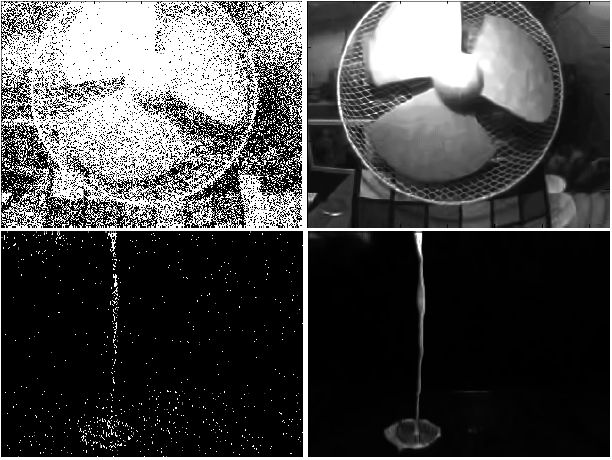 |
Quanta image sensor (QIS) is a class of single photon imaging devices that measure light intensity
using oversampled binary observations. Because of the stochastic nature of the photon arrivals, data acquired by QIS is
a massive stream of random binary bits. The goal of image reconstruction is to recover the underlying image from these
bits. In this paper, we present a non-iterative image reconstruction algorithm for QIS. Unlike existing reconstruction
methods that formulate the problem from an optimization perspective, the new algorithm directly recovers the images
through a pair of nonlinear transformations and an off-the-shelf image denoising algorithm. By skipping the usual
optimization procedure, we achieve orders of magnitude improvement in speed and even better image reconstruction
quality. We validate the new algorithm on synthetic datasets as well as real videos collected by 1-bit SPAD cameras. Publication:
Code: https://github.itap.purdue.edu/StanleyChanGroup/SingleBitRecon_MDPI_16 |
ADMM Image Reconstruction
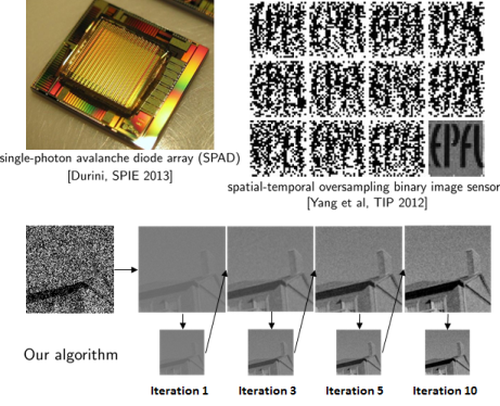 |
Recent advances in materials, devices and fabrication technologies have motivated a strong momentum in developing
solid-state sensors that can detect individual photons in space and time. It has been envisioned that such sensors can
eventually achieve very high spatial resolutions as well as high frame rates. In this paper, we present an efficient
algorithm to reconstruct images from the massive binary bit-streams generated by these sensors. Based on the concept of
alternating direction method of multipliers (ADMM), we transform the computationally intensive optimization problem
into a sequence of subproblems, each of which has efficient implementations in the form of polyphase-domain filtering
or pixel-wise nonlinear mappings. Moreover, we reformulate the original maximum likelihood estimation as maximum a
posterior estimation by introducing a total variation prior. Numerical results demonstrate the strong performance of
the proposed method, which achieves several dB's of improvement in PSNR and requires a shorter runtime as compared to
standard gradient-based approaches. Publication:
|





